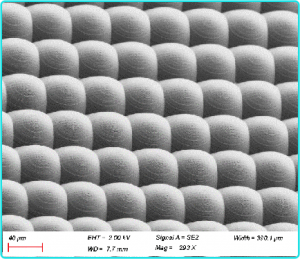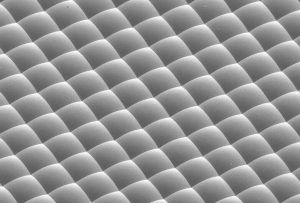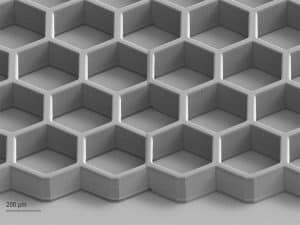
LIGA/UV-LIGA Plating | Metal Microstructures\RF Devices\Inertial Sensors\Heat Dissipation Microstructure Applications
Microsystem (Microsystem, the usual European term), Micro Electro Mechanical System (Micro Electro Mechanical System, MEMS, the usual American term) and Micromachine (Micromachine, the usual Japanese term)MEMS, as one of the five major components of intelligent microsystem implementation, is considered as microsystem technology in a narrow sense, which is essentially a comprehensive frontier technology to achieve single or multiple types of applications, involving microelectronics, informatics, optics, acoustics, chemistry, fluid mechanics, automatic control, materials science and other multidisciplinary intersections. The devices prepared by MEMS technology have the characteristics of miniaturization, integration, high stability and mass production, which have a wide range of application prospects in the fields of information, biology, automotive and military, and are of great significance for the country to maintain its technological leadership.
With the increasing demand and processing difficulty of metal microstructure devices in MEMS technology, electroplating has become an indispensable process for the realization of MEMS devices. The plating process is no longer limited to surface protection layer, but is used to prepare specific metal mechanical microstructure, functional microstructure, interconnect microstructure and thermal microstructure for MEMS by micro-area plating. The process is relatively more complex because it requires wafer-based auxiliary process steps such as seed layer preparation, lithography, etching, grinding and polishing, laser trimming, multilayer stacking, etc.
LIGA is a German acronym for "Lithography, Electroforming and Injection Molding", and is the earliest MEMS processing technology based on electroforming structures. Photolithography requires thick photoresist coating on the conductive substrate, generally using methyl methacrylate (PMMA), which has the chemical property of being dissolved by the developer after X-ray irradiation. In order not to cause deformation of the microstructure, the LIGA plating process requires the deposited metal to have minimal stress and no adhesion during the mold opening process resulting in microstructure damage. The metal microstructure model obtained by plating is called a core, and the film replication process is to mass produce micro devices through the core. Due to the very high parallelism and strong radiation intensity of X-rays, the LIGA technology is able to produce three-dimensional structures with aspect ratios up to 500, thicknesses ranging from hundreds of microns to millimeters, and smooth sidewalls with parallelism deviations in the submicron range, which is not possible with other microfabrication technologies. In addition, the LIGA technology combined with multiple mask sockets, linear movement of mask plates, tilted substrates, and back-side tilted lithography, enables the fabrication of three-dimensional tiny components with structural features such as stacked, beveled, and curved surfaces.
The process cost of LIGA technology is very high because it requires an extremely expensive X-ray light source and the fabrication of complex masks, which limits the wide application of the technology in industry. This new processing technology has comparable manufacturing performance with LIGA technology and is commonly referred to as quasi-LIGA technology or LIGA-like technology. Among them, UV-LIGA technology using UV light source to expose the photoresist is a relatively simple process in terms of cost and steps, and the most commonly used is to use SU-8 negative adhesive instead of PMMA positive adhesive as a photosensitive adhesive.It can reduce the exposure time and improve the processing efficiency. It is one of the most commonly used MEMS processing processes because of the thickness of 0.5 mm or more, the depth to width ratio of 20:1 or more, and the steep and straight sidewalls and flat surface.
UV-LIGA technology is mainly used for metal microstructures with relatively high aspect ratio requirements and simple structures, such as gears, supports, and microtubes with high aspect ratios. The largest known aspect ratio in the UV-LIGA process can reach more than 190:1, which was obtained by the University of Louisiana after the SU-8 lithography gap compensation method using Cargille refractive index matching solution.
Inertial sensors are a large class of representative applications in MEMS technology, MEMS inertial sensors mainly include MEMS gyroscopes, MEMS accelerometers, inertial switches and other typical products, integrated, low-power, low-cost MEMS inertial sensors mainly to meet the needs of civilian consumers, high-performance, special applications in the environment of MEMS sensors are mainly used in the military field. The use of body processes or surface micromachining processes to manufacture inertial sensors often require expensive equipment, in addition to lithography equipment, DRIE, anode bonding, vapor deposition and other equipment are very commonly used. The MEMS inertial sensors realized by plating technology as the main structure mainly use ultraviolet lithography and electroforming equipment, such as UV-LIGA technology can be used to prepare gyroscopes, accelerometers, inertial switches, etc.
The electroplating process has an inherent technical advantage in the preparation of MEMS RF devices, especially RF devices with high conductivity metals such as copper and gold plating as the main structure.
Microsystems composed of MEMS devices are characterized by high integration, micro-miniaturization, and powerful functions, but at the same time the structure has high requirements for system heat dissipation performance, especially with the gradual application of GaN and other third-generation semiconductor materials, resulting in a dramatic increase in system heat dissipation density and heat dissipation difficulty, which is reflected in high surface heat flux, high body heat flux density, and thermal stacking. Reducing the temperature of the device during system operation is an effective way to enhance device lifetime. Electroplating technology is capable of depositing highly thermally conductive metallic copper as a channel body structure or auxiliary structure to form a unique miniature heatsink structure.
The electroplating process has typical advantages that other micromachining technologies do not have. For one, the electroplating process is a typical additive processing method, capable of adopting an additive mode similar to multilayer stacking, which makes it easier to form three-dimensional device structures and provides a good way to prepare complex metallic microdevices; second, the electroplating process does not require expensive vacuum environment equipment, especially for device applications with mainly copper and nickel plating, and is a low-cost, batch processing method with great potential.
We offer fastMEMS device / micro and nanostructure processing design services, Feel free to leave a message to inquire.
Related Products
Related Reading
Micro and Nano Processing | MEMS Fine Processing (II)
Micro and Nano Processing | MEMS Fine Processing (II) Microfabrication Technology
Micro and Nano Processing | Process Overview
Micro and Nano Processing | Thin Film Deposition, Photolithography, Etching Overview Nanofabrication Division
Micro and Nano Processing | MEMS Fine Processing (IV)
Micro and Nano Processing | MEMS Fine Processing (IV) 1.3 Photolithography


